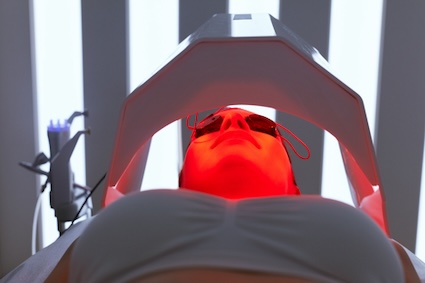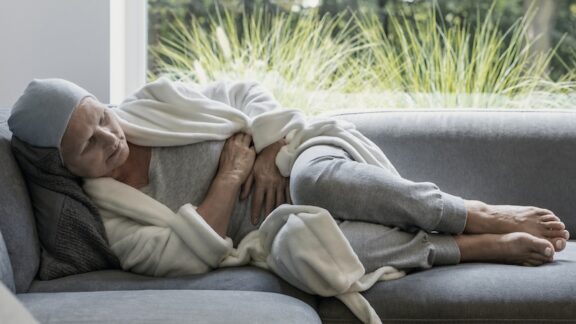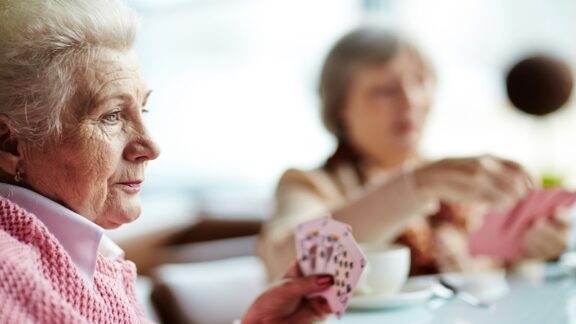A popular, futuristic-like therapy may have useful applications for older adults as well, from relieving inflammation to protecting brain health. Seniors Guide looks at the potential of red light therapy for seniors.
Red light therapy – or RLT – has become a buzzword in wellness circles, known for benefits like smoother skin, reduced joint pain, and faster exercise recovery. But some scientists are now exploring whether the same light could also support brain health and cognitive function in older adults.
So how much of the hype is hope, and how much is science?
What is red light therapy?
Red light therapy (RLT) uses low levels of visible red light (usually between 620–700 nanometers) and sometimes near-infrared (NIR) light just beyond the visible spectrum. The light is thought to stimulate tiny energy factories inside our cells – the mitochondria – to work more efficiently.
 At its most common, RLT is used for:
At its most common, RLT is used for:
- Skin rejuvenation and wound healing
- Joint and muscle recovery after exercise
- Reducing inflammation and pain in arthritis or soft-tissue injuries
It’s a non-invasive, low-heat therapy, usually delivered through LED panels, handheld devices, or flexible masks.
How red light therapy relates to photobiomodulation
You might also hear the broader term photobiomodulation (PBM). Think of PBM as the scientific umbrella that covers both red and near-infrared light therapies.
- RLT is the popular wellness term, often focused on skin and fitness recovery.
- PBM is the research term, encompassing both red and NIR wavelengths — especially when used for deeper tissues like joints, muscles, or even the brain.
In other words: all red light therapy is photobiomodulation, but not all photobiomodulation is red light therapy.
Light and the brain: the new frontier
Researchers are now studying a specific form of PBM called transcranial photobiomodulation, applying near-infrared light to the head in hopes of gently energizing brain cells.
Here’s the science in plain language:
- Mitochondria absorb certain wavelengths of red or near-infrared light.
- That absorption boosts cellular energy (ATP) and can trigger anti-inflammatory and antioxidant effects.
- Some near-infrared light can actually pass through the scalp and skull to reach surface brain tissue, potentially improving blood flow and supporting neurons.
Because reduced energy production and chronic inflammation are common features of dementia, researchers are curious: could PBM help protect or revive aging brain cells?
Early research on red light therapy for seniors
The studies so far are small but intriguing. In one trial with healthy older adults (no dementia), several PBM sessions improved performance on tasks involving focus and mental flexibility — the kinds of thinking that rely on the brain’s frontal lobes.
Another study found that adults over 50 showed better cognitive test scores and increased levels of BDNF, a protein linked to brain plasticity and growth, after a series of sessions.
For people already diagnosed with mild cognitive impairment (MCI) or early Alzheimer’s disease, early pilot studies using light “helmets” or headsets have reported improvements in attention, mood, or sleep. But researchers caution that these results are signals, not proof since the trials are short, small, and vary widely in methods.
Larger, rigorously controlled studies are still underway.
Related: ‘Keep Sharp: Build a Better Brain at Any Age’
Know before you try
Safety: Transcranial PBM appears well tolerated in research settings. The most common minor side effects include temporary warmth, mild headache, or light sensitivity. Eye protection is essential to prevent retinal exposure.
Devices: Consumer “red light” panels aren’t necessarily designed for brain treatment. The studies use specific wavelengths (often around 810 nm), power levels, and durations that typical home devices may not match. If you’re curious, ask your clinician about ongoing clinical trials or professional-grade systems.
Expectations: Even the most optimistic researchers emphasize that PBM for cognitive health is still experimental. Benefits, when they appear, are modest, not cures. The therapy is best viewed as a potential complement to established dementia care, not a replacement.
Talk with your doctor
If you or a loved one is interested in light therapy for brain health:
- Bring the device specifications (wavelength, power, session time).
- Ask whether clinical trials in your area are recruiting participants.
- Discuss how it might fit with other care strategies – medications, physical activity, social engagement, and good sleep.
Bottom line on red light therapy for seniors
Red and near-infrared light therapies – from skincare panels to clinical photobiomodulation systems – all work on the same principle: helping cells produce more energy and reduce inflammation.
For skin, joints, and muscle recovery, red light therapy already has a solid foothold in wellness routines.
For brain health, the science is hopeful but early. It appears safe and feasible, but we still need large, long-term, well-controlled trials to know whether it can meaningfully slow or improve cognitive decline.
Until then, consider light therapy a promising companion to, not a substitute for, proven habits that keep the brain bright: exercise, social connection, good sleep, and lifelong learning.
Original article written by John Levan, made more reader-friendly using ChatGPT AI.




